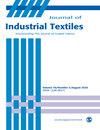用于纺织织物和织物湿度传感应用的高品质因数双负超材料
IF 2
4区 工程技术
Q1 MATERIALS SCIENCE, TEXTILES
引用次数: 0
摘要
本研究介绍了一种创新型高品质因数(Q 因子)双负(DNG)超材料传感器,设计用于纺织品创新动态领域中的纺织面料和面料湿度传感应用。该传感器专门用于检测不同纺织面料的介电性能和含水量。这种超材料结构的高 Q 因子可确保提高织物传感的灵敏度和准确性,从而有助于精确检测织物属性的细微变化。通过测量频率偏移和分析 S21 值,传感器可提供有关织物介电特性的重要信息。在各种织物(包括棉、牛仔布、灯芯绒、欧根纱和涤纶)上进行的传感实验揭示了频率偏移和 Q 因子的独特模式,在织物结构和传感器性能之间建立了微妙的联系。所提出的传感器能够检测介电常数变化极小的织物(0.05)。在实验中,高介电常数织物牛仔布(1.7)的频率偏移和 Q 因子分别为 6970 和 834.87。此外,值得注意的是,低介电织物欧根纱(1.03)的频率偏移和 Q 因子分别为 2190 和 1367.03。实验结果证实了所提出的传感器在织物和织物湿度传感方面的突出功效。它的高 Q 因子使传感器能够准确地检测和监测织物特性,因此非常适合纺织行业的质量控制、能效优化和流程改进等关键任务。所提出的超材料传感器(MMS)可极大地促进智能纺织品传感技术的发展,并为纺织业的创新应用铺平道路。本文章由计算机程序翻译,如有差异,请以英文原文为准。
High quality factor double negative metamaterial for textile fabric and fabric moisture sensing applications
This study introduces an innovative high-Quality factor (Q-factor) double negative (DNG) metamaterial sensor designed for textile fabric and fabric moisture sensing applications in the dynamic realm of textile innovation. The sensor is specifically designed to detect the dielectric properties and moisture content of different textile fabrics. The high Q-factor of this metamaterial structure ensures heightened sensitivity and accuracy in fabric sensing, facilitating precise detection of even subtle changes in fabric properties. By measuring frequency shifting and analyzing S21 values, the sensor provides crucial information about the fabric’s dielectric characteristics. Sensing experiments conducted on various fabrics, including cotton, denim, corduroy, organza, and polyester unveil distinctive patterns of frequency shifting and Q-factors, establishing a nuanced link between fabric structure and sensor performance. The proposed sensor is capable of detecting fabrics with a very low dielectric constant variation of 0.05. In the experiment, the high-dielectric fabric denim (1.7) exhibited frequency shifting and Q-factor of 6970 and 834.87, respectively. Moreover, it is worth noting that the low-dielectric fabric organza (1.03) exhibits frequency shifting and Q factors of 2190 and 1367.03, respectively. Experimental results affirm the prominent efficacy of the proposed sensor in fabric and fabric moisture sensing. Its high Q-factor empowers the sensor to accurately detect and monitor fabric properties, rendering it highly suitable for critical tasks such as quality control, energy efficiency optimization, and process enhancement within the textile industry. The proposed metamaterial sensor (MMS) can significantly contribute to the development of a smart textile sensing technology and pave the way for innovative applications in the textile industry.
求助全文
通过发布文献求助,成功后即可免费获取论文全文。
去求助
来源期刊

Journal of Industrial Textiles
MATERIALS SCIENCE, TEXTILES-
CiteScore
5.30
自引率
18.80%
发文量
165
审稿时长
2.3 months
期刊介绍:
The Journal of Industrial Textiles is the only peer reviewed journal devoted exclusively to technology, processing, methodology, modelling and applications in technical textiles, nonwovens, coated and laminated fabrics, textile composites and nanofibers.
 求助内容:
求助内容: 应助结果提醒方式:
应助结果提醒方式:


